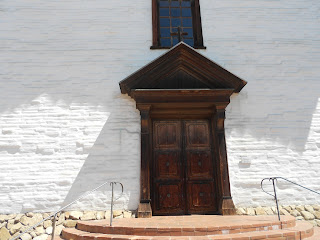The old historic
Mission San Jose was founded on June 11, 1797. The location is in today's
Fremont California, not San Jose. Mission San Jose has the distinction of being the
fourteenth Spanish mission built in
Alta California. It also is the only mission, among all Spanish missions, built in the East Bay area. The name of the mission when founded was officially, "
La Mision del Gloriosisimo Patriarch San Jose" in honor of St. Joseph.
 |
| Mission San Jose |
The closest mission to it is about thirteen miles south in Santa Clara California, Mission Santa Clara, and is on today's campus of
Santa Clara University. Many people confuse the Mission San Jose with the old pueblo town of San Jose to the south. The two are completely different. The only similarity is that they both honor St. Joseph in their name.
Today, the mission is just off of the East Bay Area's busy
Interstate 680 as it turns west over the hills toward the city of Livermore. There's no question as to why Mission San Jose California sits alongside such a major roadway. When the mission was built by
Father Fermin Lasuen. The mission site was chosen because it was along the natural highway in 1797 to the west and the
San Joaquin Valley. Interstate 680 today basically follows the same path carved out by the early Spaniards as they were colonizing what was then called Alta California. It's also believed that Mission San Jose would have been constructed in the San Ramon Valley, east and over the hills from it's present site, however the Indians in the valley to the east were considered too hostile at the time. This explains why the mission is so relatively close to the Santa Clara Mission.
 |
| Portico at Convento section of San Jose Mission |
All of the Spanish missions, beginning with the mission in San Diego in 1769, were founded to strengthen Spain's claim on the region and to Christianize the Native population. Securing Spain's sovereignty over the region, and in particular northern California, was an important matter. Spain was well aware of the Russian fur trade taking place in the northern coastal area of California, not far north of San Francisco Bay, and the British trading taking place further north in the Oregon territory. Because of all this, the Spanish mission system truly had a dual role.To say the Spanish missions were forts or presidios is incorrect but the relationship between the two entities was close.
The Mission San Jose California is also located where the Ohlone Indians were settled. The Ohlone Indian tribe resided in an area from San Francisco Bay down to Monterey Bay and present day Salinas California. The Ohlone's like all native peoples had their own religion. In their case it was "
shamanism". Shamanism is a spiritual practice with a degree of magic involved. It was an ancient religion. Prior to the arrival of the Spaniards, the Ohlone's survived by hunting, fishing, and gathering. Of course, when the Spanish missionaries arrived all of this would change and the change wouldn't necessarily be easy to accomplish.
 |
| San Jose Mission front entrance |
Spanish missions were set up as self sustaining villages. The missions housed some soldiers, Native Indians, artisans and perhaps two priests. The Spanish government also set up a unique plan for the land and the resources that the missions used. Spain declared that the mission's land and
resources were actually owned by the native population and and would be given back to them when
they had learned to manage themselves in the Spanish way. At this time the Natives in effect would be subjects of the King of Spain. Spain's colonization efforts stood in contrast to the later westward expansion on the North American continent which was led by the U.S. Army and particularly the U.S. Cavalry. The Spanish mission system ended when Mexicans expelled the Spaniards from North America in the 1820's. The missions were secularized by the new Mexican government but it's interesting to note that the very last mission in Sonoma California,
Mission San Francisco Solano, was built under Mexican rule. The impetus appeared to be the concern with Russians traders operating not far north of Sonoma and Mission San Francisco Solano would also serve as a military outpost. The last Mexican military commander in Sonoma was
General Mariano Vallejo who ultimately became a supporter of California statehood in 1850.
 |
| Mission grounds entrance monument |
The original mission made of adobe and timber was destroyed by an earthquake in 1868. The present day museum is located in the West Wing which housed the convento and was not destroyed. The church was rebuilt as a Gothic styled mission in the exact spot as the original. In 1985 a new mission was completed that reflected the same way the original mission had looked. It is considered by all to be an almost perfect replica of the original mission. At the same time the museum building was brought up to earthquake specifications.
Two additional articles we've published on Western Trips that you'll find interesting at the
Carmel Mission in Carmel California and the
Mission Santa Clara de Asis on the campus of Santa Clara University just outside San Jose.
You may also enjoy our travel article on
Beautiful Tomales Bay California.
Two excellent books on the Spanish missions are The Spanish Missions of California by author Megan Gendell and The California Missions: A Complete Pictorial History and Visitor's Guide by the Editors of Sunset Books.
(Photos are from author's private collection)





